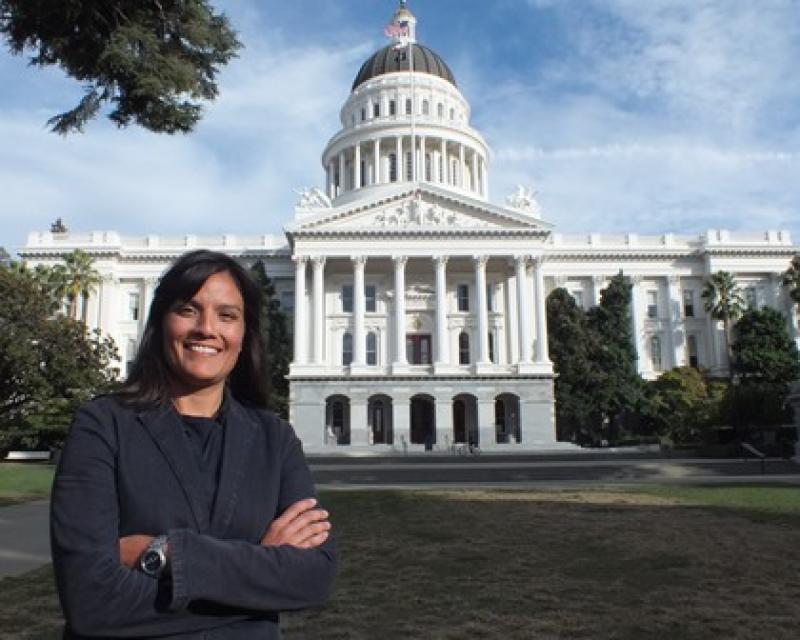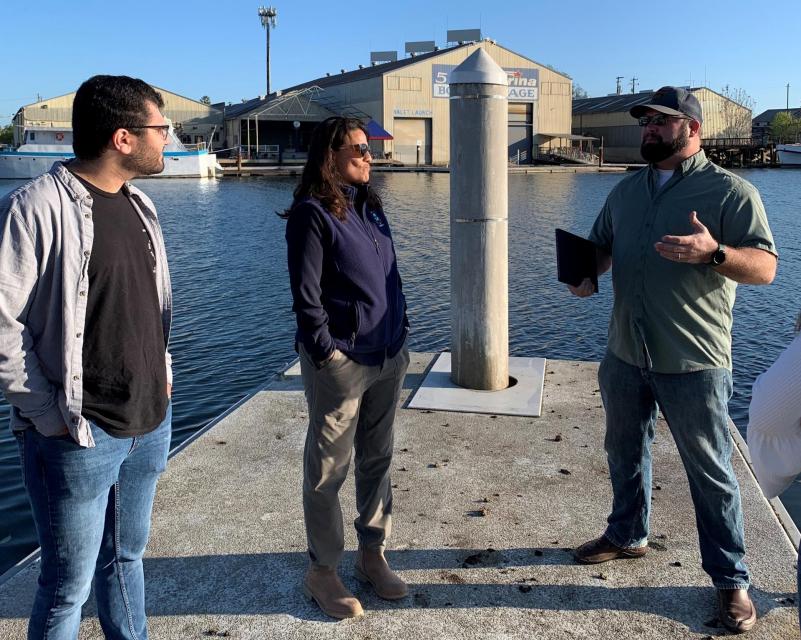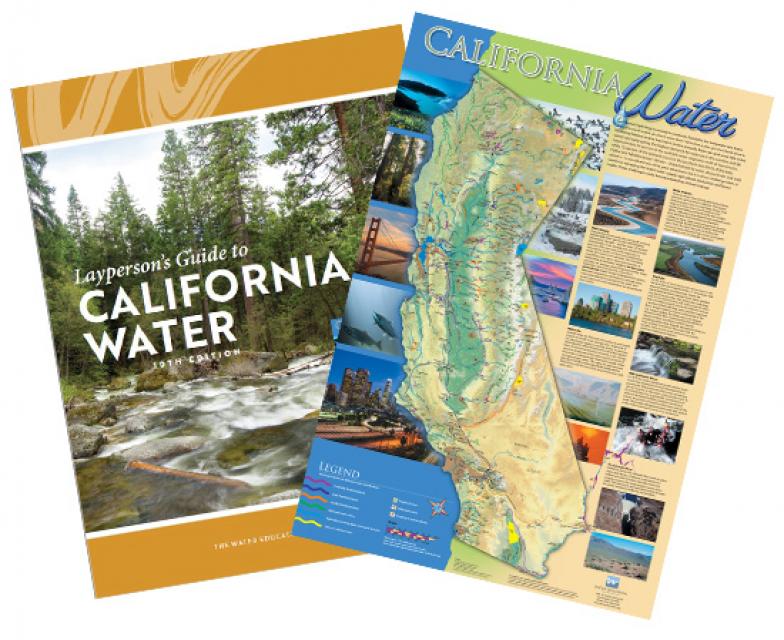New EPA Regional Administrator Tackles Water Needs with a Wealth of Experience and $1 Billion in Federal Funding
WESTERN WATER Q&A: Martha Guzman says surge of federal dollars offers 'greatest opportunity' to address longstanding water needs, including for tribes & disadvantaged communities in EPA Region 9
 Martha Guzman recalls those awful
days working on water and other issues as a deputy legislative
secretary for then-Gov. Jerry Brown. California was mired in a
recession and the state’s finances were deep in the red. Parks
were cut, schools were cut, programs were cut to try to balance a
troubled state budget in what she remembers as “that terrible
time.”
Martha Guzman recalls those awful
days working on water and other issues as a deputy legislative
secretary for then-Gov. Jerry Brown. California was mired in a
recession and the state’s finances were deep in the red. Parks
were cut, schools were cut, programs were cut to try to balance a
troubled state budget in what she remembers as “that terrible
time.”
She now finds herself in a strikingly different position: As administrator of the U.S. Environmental Protection Agency’s Region 9, she has a mandate to address water challenges across California, Nevada, Arizona and Hawaii and $1 billion to help pay for it. It is the kind of funding, she said, that is usually spread out over a decade. Guzman called it the “absolutely greatest opportunity.”
Guzman, who was appointed EPA Region 9 administrator in December, not only has a wealth of federal dollars to work with, but she also brings a wealth of experience to her new role. As Brown’s deputy legislative secretary, she worked on a variety of water-related issues, including the 2012 human right to water law and the 2014 Sustainable Groundwater Management Act. In 2016 Brown appointed her to the California Public Utilities Commission, where she worked on issues of water affordability, clean energy, expanding broadband access, fiscal oversight of utilities and preventing disconnections of basic utilities for disadvantaged communities.
Guzman participated in the Water Education Foundation’s Water Leaders program in 2000. You can read more about her experience here.
Guzman talked with Western Water about how her past experiences have informed her work at EPA, some of the top priorities in EPA Region 9 and how the bipartisan infrastructure funding law is providing a unique opportunity to address water needs, including for tribal nations and disadvantaged communities.
WW: You were with the California PUC for about five years, and the Governor’s office before that. How is that experience informing you in your new position?
GUZMAN: Well, it’s just a tremendous amount of
knowledge, of course. In the governor’s office, I probably had
more crossover on the issues with all the natural resources
agencies and Food and Agriculture, and really that’s the overlap
with EPA.  And then in my time with
CPUC, it was very energy focused and broadband, water there as
well, very focused on what the customer sees at the end of the
day on their bill. And of course, how we can make all these
resources accessible to everyone and as clean as possible.
And then in my time with
CPUC, it was very energy focused and broadband, water there as
well, very focused on what the customer sees at the end of the
day on their bill. And of course, how we can make all these
resources accessible to everyone and as clean as possible.
I do feel like I got like a bachelor’s degree at each one of those [positions] in those issue areas. Particularly in the governor’s office, where you have not just the state’s experts, but in many cases national and international top experts briefing you on issues. I did get a lot of great experience to serve me here, particularly to the benefit of California, of course. But many of the states in the Pacific Southwest have a similar set of issues – Arizona, Nevada deal with the same type of drought challenges, of course, and in some instances, even worse than California.
WW: What can California water agencies and communities dealing with drought, poor water quality and aging water infrastructure expect from EPA Region 9 during your tenure?
GUZMAN: Well, I have the absolutely greatest opportunity, which is the bipartisan infrastructure law. When I went into the Brown administration, we were in a recession still and had a tremendous deficit, and we were cutting. But we are in this moment [now] where, because of the economic stimulus that Congress and the president have taken, I have this great opportunity of resources. For Region 9, we’re going to have $1 billion of investments for water. We’re going to have augmentation of the clean water, of the drinking water SRFs [State Revolving Funds], $450 million. These are numbers that we usually see over the span of a decade. The great thing I really am excited about, as well, is the way that the federal government has really targeted a set of investments for the tribal nations, and they also have a huge amount of specific set-aside. For the region, it will be $154 million for our tribes.
It’s just exciting to be able to fund things that in the past were not possible because of the financing not being there. And the other really critical piece of this, which has been an overarching theme of the Biden administration, is the Justice 40 commitment, which is that a minimum of 40 percent of these investments are going to go to disadvantaged communities. And in the case of these funds for the water infrastructure, 49 percent is going to go in the form of grants to disadvantaged communities…. And so now we have just an amazing amount of funding to try to get at some of these issues that are not new, dealing with drought, dealing poor water quality, aging infrastructure.
WW: What are your highest water-related priorities in California, and the Southwest in general for Region 9 to address?
 GUZMAN: Some of
these issues are issues that Region 9 alone cannot address. But
we know that the highest priority is really adapting to drought.
And in some cases, that can mean the expansion of the groundwater management
systems so that they can have a more accurate knowledge of the
groundwater in these dry years and really manage the system.
GUZMAN: Some of
these issues are issues that Region 9 alone cannot address. But
we know that the highest priority is really adapting to drought.
And in some cases, that can mean the expansion of the groundwater management
systems so that they can have a more accurate knowledge of the
groundwater in these dry years and really manage the system.
As I’ve talked about water infrastructure, which of course includes water recycling, and the capturing and reuse, which is an ever-increasing strategy for drought. And these funds will be used to expand on that. And there’s pollution, the pollution issues that, again, are not just due to Superfund [EPA’s hazardous waste cleanup program], but also the naturally occurring arsenic that is pervasive, and of course the nitrate contamination. And PFAS [a widely used, long-lasting group of chemicals] is the latest contaminant that will also be requiring a tremendous amount of treatment.
WW: PFAS has turned up in wells around California, particularly in communities near old military bases and airports. EPA has provided some help to water agencies (such as Orange County Water District) via loans through the Water Infrastructure Finance and Innovation Act. What else is it doing to address PFAS contamination in water systems in this state?
GUZMAN: It’s a major initiative, nationally. There was a national strategic roadmap that was put up last October that includes everything from research, strategies for how we can prevent PFAS from entering the environment. And then, of course, the remediation part, which is the focus that we really have on the drinking water side.
There is a proposal in the Federal Register that came out in December. We’re going to put some primary drinking water regulations out on two PFAS chemicals that are of greatest concern, PFOA and PFOS. We’re going to propose those in the fall and we hope to finalize those next year. And then on the funding side, again, the bipartisan infrastructure law includes $10 billion to really focus on PFAS and other emerging contaminants, particularly looking at not just treatment but also on the wastewater side and in looking at the whole system and trying to source some of the problems.
Martha Guzman Aceves
- Education: Bachelor of Science in international economics from Georgetown University, Master of Science in agricultural and resource economics from the University of California, Davis.
- Current job: EPA Region 9 Director
- Previous jobs: Commissioner at the California Public Utilities Commission; deputy legislative affairs secretary, Office of the Governor; sustainable communities program director, California Rural Legal Assistance; human resources staffer at Swanton Berry Farm; legislative coordinator for United Farm Workers.
- Fun fact: Guzman said her career in water began at Georgetown University, where she was manager of the women’s basketball team – or, as she put it, the team’s “water girl.” The position qualified her for a full-ride athletic scholarship under Title IX – and, because the team won the Big East Championship one year, she got a Big East ring, as well.
WW: At the PUC, part of your portfolio involved water affordability and access. Are those still part of your responsibilities as EPA Region 9 administrator? And if so, how is Region 9 improving water access and affordability?
GUZMAN: I would say the access part is obviously much more of the focus and affordability part is more indirect in the form of financing. And I just can’t stress enough how much this 49 percent grant strategy really helps with affordability.
There’s a tremendous amount of infrastructure need for purposes of access, and many of our tribal communities still have really basic access.
~Martha Guzman, EPA Region 9 Administrator
But we obviously aren’t in in the space of the very localized ratemaking. In California, over 80% of systems are public, so much of the affordability is really driven by local government, and some private. But our piece of the puzzle here is to do everything possible to expand access. There’s a tremendous amount of infrastructure need for purposes of access, and many of our tribal communities still have really basic access. The State Water Board has an initiative around SAFER communities and having access to more sustainable water provision is a big part of that. So we’re working very closely with them on the projects that facilitate that. We hope to do the same with the other states, Arizona, Nevada, Hawaii.
And some of it, like in the Hawaiian side, will be more focused around access to safe sanitation. We forget to talk about the importance of that. In the Coachella Valley, it’s not just a drinking water issue, it’s [also] a sanitation issue.
WW: Transborder pollution from Tijuana has been an ongoing problem for San Diego County. The U.S.-Mexico-Canada Trade Agreement (USMCA, the new NAFTA) committed $300 million toward improvements, but the upgrades are expected to cost $627 million to build. What’s EPA doing to secure the rest of the funding? How long will these improvements take to implement?
GUZMAN: I would say $300 million is what came from USMCA and the approach that was taken by, again, this binational, different levels of government, all-inclusive and planning approach that was utilized, was to set up a vision for the whole solution. Even if our funding takes us a certain stretch of the way, we wanted to know what the comprehensive vision was. And that will facilitate not just ourselves from looking to the administration to try to secure greater funding, but also all the other governments, including the Mexican side. As an example, the California legislature held a discussion around this and they are looking to potentially secure additional resources in the California state budget. That’s the value of having kind of a long-term vision out there is that we can build towards it.
I think a big part of that is, we have to start spending the $300 million as that’s almost the best way to really show that there’s more needed.
Reach Douglas E. Beeman: dbeeman@watereducation.org, Twitter: @dbeeman
Know someone else who wants to stay connected with water in the West? Encourage them to sign up for Western Water, and follow us on Facebook , Twitter, LinkedIn and Instagram.










